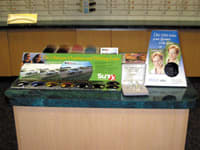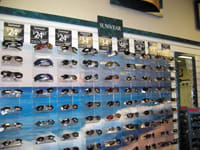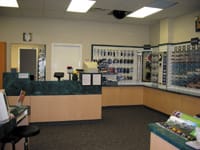Reigning
Supreme
In little more than 40 years Wal-Mart has grown from a single store opened in Arkansas to the country's number one retailer with more than $244 billion in sales last year alone. Today, with over 1,500 Wal-Mart Vision Centers in full swing across the country, this retail giant has aggressive plans for its optical future
By Erinn Morgan
|
Secrets of Success |
|
"We're all working together; that's the secret. And we'll lower the cost of living for everyone, not just in America, but we'll give the world an opportunity to see what it's like to save and have a better lifestyle, a better life for all. We're proud of what we've accomplished; we've just begun." --Sam Walton (1918-1992). |
|
Shoppers come for everything from gas to green beans and footwear to eyewear. Every week, Wal-Mart Stores, Inc., serves more than 138 million customers in 50 states, Mexico, Puerto Rico, Canada, Argentina, Brazil, China, Korea, Germany, and the United Kingdom. People come to get their hair and nails done, their cars fixed, and their family photos developed. They shop for groceries, camping equipment, tires, toys, and computers.
They come because it is Wal-Mart--the one-stop shopping phenom. A marketing wonder focused on quality goods at "Everyday Low Prices," this chain store has become part of the fabric of our everyday lives. "Wal-Mart Supercenters are designed to give our customers a 'one-stop shopping' experience by adding the convenience of finding all of their needs under one roof--including their eyecare needs," says Karen A. Burk, Wal-Mart spokeswoman.
This company is a case study in success, growing from the humble Southern beginnings of one small store to an international retail giant with more than 1,600 Wal-Mart discount stores, 1,100 24-hour Supercenters, 30 Neighborhood Markets, 500 SAM's CLUBS, and 1,301 Wal-Mart International units. As a testament to its drive, Wal-Mart, Inc. recently had the biggest single-day sales in history--$1.43 billion on the day after Thanksgiving in 2002.
|
|
|
|
Wal-Mart is home to 1,125 corporate optical departments and 375 leased Vision Center departments operated by National Vision, Inc. |
VISION QUEST
The company's campaign for success in optical follows suit. The first Vision Center was opened in 1990. Today, Wal-Mart, Inc. boasts 1,125 corporate departments and 375 leased Vision Center departments (operated by National Vision, Inc.) located in Wal-Mart Supercenters and SAM's CLUBS, making it the nation's third-largest optical retailer.
Expansion plans are aggressive as well. "We plan to have a Vision Center in every Wal-Mart Supercenter and every SAM'S CLUB," says Burk. This is no small task, as the company has announced plans to open approximately 200 to 210 new Supercenters during the fiscal year that began Feb. 1, 2003.
While the Wal-Mart Vision Centers are making an impact on the optical industry with product, prices, and programs--such as a push on anti-reflective coatings (AR)--eyecare professionals across the country are forced to pull out the competitive stops.
"The pressures to compete with Wal-Mart are tremendous, especially in a more rural or suburban area," says William C. Thomas, Vision Council of America (VCA) executive vice president and CEO. Still, he says, Wal-Mart is doing the industry a service as it educates consumers about eyewear and the need for yearly eye exams (see sidebar, page 94). Many agree that the proliferation of information about eyewear could trickle down to increased sales of premium products for everyone.
|
|
|
|
Located in the front of most Wal-Marts and SAM's CLUB stores, the Vision Centers are a store within a store. Below, a lens center to educate patients |
|

|
ECPs in these markets say there continues to be room for competing formats.
FORMAT AND MIX
The Wal-Mart Vision Centers are typically located at the front of Wal-Mart discount, Supercenter, and SAM's CLUB stores. They feature a store-within-a-store format and appear to be a separate retail environment. Most have an in-house optometrist for eye exams and opticians who handle dispensing.
The frame selections are primarily shown on the walls and separated into categories--men's with prices from $18 to $158, women's from $18 to $128, kids' from $18 to $94, safety glasses from $27 to $97, and sports eyewear from $32 to $68.
Brands include Geoffrey Beene, Halston, Wrangler, Seventeen, CoverGirl, and Jordache. There are also reader and clip-on sunlenses sections. Private label product also appears at Wal-Mart Vision Centers.
There is even an apparent push on the higher end, for example, with $158 flexible metal frames that come with a polarized magnetic clip-on sunlens and titanium frames priced at $94.
Plano sunwear prices range from $19.97 to $89.72. Many models are metal with slight wrap styling. Some polarized options are offered.
An accessory collection includes cases, cords, chains, and cleaners. Leather and neoprene retainers range from $2.97 to $3.97 and beaded chains are priced at $5.97. Hard cases run from $3.94 to $7.94. Clip-on models are offered, ranging in price from $14.97 to $19.97. Fit-over eyewear styles are also displayed, as are small baskets filled with cleaners, cloths, and cases.
Lenses are a focus at the Wal-Mart Vision Centers. P.O.P. materials promote the benefits of AR (an additional charge of $35), polarization, No Glare coating, and the $25 "Camouflage" edge treatment.
|
|
|
|
A collection of sunwear choices on the frame boards |
Each dispensing table features a mat with four levels of lens options, from top to bottom. The "Ultimate" features a 1.67 high index lens with No Glare and scratch resistance for $125. The next level is the "Ultra," a 1.56 mid index lens with No Glare and scratch resistance for $95. "Premium" is the next lens package and is a polycarbonate lens with No Glare and scratch resistance priced at $80. The final package is "Performance," a CR 39 lens that comes with No Glare, UV protection, and scratch resistance for $60.
Other options offered on this dispensing mat: A fashion tint with UV for $15 and single-vision plastic with UV for $30. Transitions lenses are available for a $65 additional charge.
In addition to product and promotion, Wal-Mart puts the onus on customer service. Customers are first welcomed as they step into the main store entrance by Wal-Mart "greeters."
This feel-good philosophy is proliferated in the optical shop with a friendly staff that has been trained to educate. Of course, low prices don't hurt either.
With a targeted philosophy, strong product mix, and low price strategy, this retail powerhouse promises to be a force to keep our eyes on for years to come.
|
Wal-Mart Facts |
|
|
Leased Locations |
In addition to its corporate-run Vision Centers, Wal-Mart, Inc., has approximately 381 domestic and 37 Mexico locations leased to and run by National Vision, Inc. About 25 percent are in Supercenters and the rest are in the traditional Wal-Mart discount stores. "It is a very similar operation to ours in that they have doctors for vision screenings as well as the sales side of the business for frames, etc.," says Karen A. Burk, Wal-Mart spokeswoman. According to National Vision, Inc., its leased Vision Centers were launched 12 years ago and today offer "complete eyeglasses starting at $40, including single vision SureValue lenses. Eyeglass frames range from classic, good quality styles to designer names including CoverGirl, Halston and NBA." The leased centers feature a mix slightly different from the corporate departments. "We carry a different frame and lens selection, but not entirely," says Reade Fahs, president and chief operating officer of National Vision, Inc. "The pricing is similar but not exactly the same either. We watch each other and see what works in these areas. Everybody wins--especially the consumer." One-hour service is also available for a $10 charge. National Vision, Inc., also operates optical centers in other retail outlets, including 58 in Fred Meyer stores and 23 on military bases throughout the United States. |
|
Wal-Mart Timeline |
1962: Company founded with opening of first Wal-Mart in Rogers, Ark.1967: Wal-Mart's 24 stores total $12.6 million in sales. 1970: Wal-Mart opens first distribution center and home office in Bentonville, Ark. Wal-Mart stock first traded over the counter as publicly held company. There are 38 stores now in operation with sales at $44.2 million. Total number of associates is 1,500. 1971: First 100 percent stock-split in May. Market price: $47. 1972: Wal-Mart approved and listed on the New York Stock Exchange. 1977: Wal-Mart makes first acquisition, 16 Mohr-Value stores in Michigan and Illinois. 1978: Hutcheson Shoe Company acquired; Wal-Mart pharmacy, auto service center, and jewelry divisions introduced. 1979: Wal-Mart is the first company to reach $1 billion in sales in such a short period of time: $1.248 billion. 1983: First SAM'S CLUB opened in April in Midwest City, Okla. 1983: People Greeter implemented at all stores. First one-hour photo lab opened in Tulsa, Okla. 1983: For eighth year straight Forbes Magazine ranks Wal-Mart number one among general retailers. 1984: Sam Walton does the hula at high noon on Wall Street, making good on promise to associates after company achieves pre-tax profit of 8 percent in 1983. 1987: Wal-Mart's 25th anniversary: 1,198 stores with sales of $15.9 billion and 200,000 associates. Wal-Mart Satellite Network (largest private satellite communication system in the U.S.) completed, linking all operating units of company and General Office with two-way voice, data, and one-way video communication. 1988: First Supercenter opened in Washington, Mo. Ninety percent of Wal-Mart stores have bar-code scanning capabilities. 1990: Wal-Mart becomes nation's number one retailer. 1990: Wal-Mart Visitor's Center opens on the site of founder Sam Walton's original Walton's 5-10 store. 1991: "Sam's American Choice" brand products introduced. International market entered for first time with the opening of a unit in Mexico City. 1992: President George Bush presents Sam Walton with the Medal of Freedom. Sam Walton dies April 5. 1992: S. Robson Walton named chairman of the board April 7. Wal-Mart enters Puerto Rico. 1993: First billion-dollar sales week in December. 1994: A prototype store designed to be as environmentally friendly as possible opens in Lawrence, Kans. 1995: Wal-Mart Stores, Inc. has 1,995 Wal-Mart stores, 239 Supercenters, 433 SAM'S CLUBS and 276 International stores with sales at $93.6 billion and 675,000 associates. 1996: Wal-Mart enters China through a joint-venture agreement. 1997: Wal-Mart becomes the number one employer in the United States with 680,000 associates, as well as an additional 115,000 international associates. Wal-Mart Stores, Inc. serves more than 90 million customers a week worldwide. 1998: Wal-Mart introduces Neighborhood Market concept with three stores in Arkansas. Wal-Mart exceeds $100 million in annual charitable contributions, with donations totaling $102 million. And, the company has its first $100 billion sales year, with sales totaling $105 billion. 1999: Wal-Mart has 1,140,000 associates, making the company the largest private employer in the world. Wal-Mart ranked number one Corporate Citizen in America in the 1999 Cone/Roper Report, an annual national survey on philanthropy and corporate citizenship. 2000: Wal-Mart is ranked fifth by FORTUNE magazine in its list of Global Most Admired All-Stars. 2001: Wal-Mart named by FORTUNE Magazine as the third most admired company in America. 2002: Wal-Mart named by FORTUNE magazine as the most admired company in America. 2002 Wal-Mart ranked number one on the FORTUNE 500 listing. |
|
|
|
|
|
|
|
Top: A contact lens fitting room. Center and bottom: Wal-Mart's dispensaries are open and airy with men's, kids', women's, and specialty products displayed primarily on frame boards |
|
Eyecare and more...At Wal-Mart |
Wal-Mart, Inc.'s Vision Centers have recently signed on to promote Check Yearly. See Clearly. (CYSC), the vision community's campaign to better educate Americans about the importance of regular eye exams. The participation of Wal-Mart, the nation's third-largest optical retailer, is expected to have a profound effect on the campaign. "With more than 1,500 locations," says William C. Thomas, Vision Council of America (VCA) executive vice president and chief executive officer, "they can educate millions of people about the importance of regular eye exams for every member of the family." The promotion will include children's CYSC brochures, printed decals, and posters, plus the distribution of three million insert cards that will be placed in the case of every pair of eyewear and contact lenses sold. "The insert talks about the importance of regular eyecare," says Thomas. CORPORATE CONSCIENCE
|









